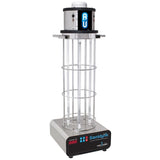Research Shows 285nm UV LEDs Kill Coronavirus
Posted by Nick on for ProLampSales

New research from Tel Aviv University in Israel showed that LEDs emitting 285nm wavelength ultraviolet light have germicidal effectiveness against coronaviruses. The study was published in the November 2020 issue of the Journal of Photochemistry and Photobiology B: Biology.
Why It Matters
This study was another indication that UV lights should be included in any disinfection process. For years, businesses and governments have been installing UVC fixtures for various applications, but this solution has been given much greater attention due to the COVID-19 response.
The researchers suggested that disinfection systems be installed in building ventilation systems and air conditioners to sterilize air circulating in rooms and buildings.
So far, numerous wavelengths of ultraviolet light have been tested and shown to be effective against coronaviruses, including the SARS-CoV-2 virus that causes COVID-19.
- 222nm Far UV has been in the news since February as a very new and expensive technology that may prove less harmful to human skin and eyes. There are few manufacturers of far UVC systems to date, but that will change in the future.
- 254nm Traditional UVC is still widely available from many high-quality manufacturers. Signify and Boston University showed that 25mJ/cm2 of UV dosage could inactivate more than 99.9999% of the SARS-CoV-2 virus.
- 285nm UV-Emitting LEDs are the latest wavelength to be tested in this study and were shown to destroy coronaviruses.
By The Numbers
- 99.9% of the coronaviruses were estimated to have been destroyed in less than 30 seconds of exposure to the 285nm wavelength LED light.
- 285nm LEDs are less expensive than 265nm LEDs without sacrificing significant germicidal power.
- 260-265nm is the peak of UV absorption by bacterial DNA. Other types of microbes (viruses, fungi, mold, yeast) have similar peaks around this range. However, wavelengths outside of this range can also be very effective against pathogens. Being outside the peak does not mean that certain wavelengths are not germicidal.
UVB, Not UVC
Wavelengths between 280-320nm are in the UVB range, which means they are not a UVC light. That should be noted, although the 285nm wavelength the researchers tested is very close to the border between UVC and UVB.
Not as Effective as LP Mercury UVC
According to most graphs showing germicidal effectiveness, 285nm light is still less effective than standard 254nm UVC bulbs. These are the fluorescent and CFL type germicidal tubes that are widely used and will continue to be far less expensive than UVC LEDs.

What Can You Do?
The researchers suggested various applications for the UVC LEDs, but many solutions already exist and are cheaper than LEDs. These are some of the applications suggested and potential solutions we offer.
Disinfecting surfaces inside of homes was discouraged, and ScienceDaily states that, "It is important to note that it is very dangerous to try to use this method to disinfect surfaces inside homes." However, ultraviolet air disinfection in residential ventilation systems has been shown to be effective.
Featured Products (View All)
- 0 Comments
- Posted in Ultraviolet Light
0 Comments




